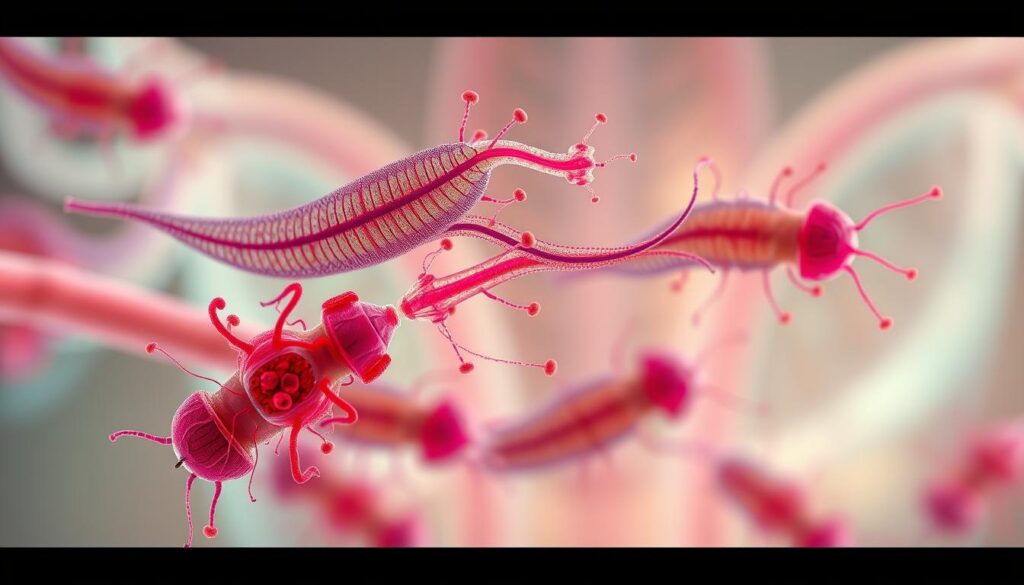Trichomoniasis is a widespread sexually transmitted infection affecting millions of Americans. This parasitic disease can occur in both men and women. Often, it doesn’t show noticeable symptoms1.
Knowing about trichomoniasis is vital for your sexual health. It helps prevent potential complications2. Around 2.6 million people in the United States have this infection2.
Many people don’t know they have trichomoniasis. However, it can cause health risks. Symptoms may include vaginal discharge and genital discomfort3.
Your risk increases with multiple sexual partners and unprotected sex. The infection can develop in 4 to 28 days after exposure3. African American women are more likely to get this infection1.
Key Takeaways
- Trichomoniasis affects approximately 2.6 million people in the US
- Most infected individuals show no symptoms
- The infection can be transmitted through sexual contact
- Regular testing is crucial for sexually active individuals
- Antibiotics are the primary treatment method
Understanding Trichomoniasis: Causes and Risk Factors
Trichomoniasis is a widespread parasitic infection affecting millions globally. It’s caused by Trichomonas vaginalis, a tiny organism that can silently impact sexual health4. Knowing its causes and risk factors helps prevent and detect it early.
What Causes Trichomoniasis
The Trichomonas vaginalis parasite spreads mainly through sexual contact. It infects the lower genital tract in both women and men5. In 2020, about 156 million new cases occurred worldwide among 15-49 year-olds5.
Common Risk Factors
Your risk of getting trichomoniasis increases with certain behaviors and traits:
- Having multiple sexual partners
- Engaging in unprotected sexual activities
- Previous history of sexually transmitted infections
- Not getting regular sexual health screenings
Surprisingly, about 70% of infected people show no symptoms4. This makes it easy to spread the infection unknowingly. Global stats reveal some interesting patterns:
- Females account for 73.7 million cases
- Males represent 82.6 million cases
- The WHO African Region has the highest prevalence
Sexual health awareness is key to preventing the spread of trichomoniasis.
Reinfection is common, with 1 in 5 people getting it again within 3 months after treatment4. This shows the need for thorough treatment and partner screening.
Recognizing Symptoms and Treatment Options
Trichomoniasis is a common sexually transmitted infection. It’s caused by the Trichomonas vaginalis parasite. Only about 30% of infected people show noticeable symptoms.
Women with trichomoniasis may experience these symptoms:
- Frothy, yellow-green vaginal discharge6
- Genital redness and irritation
- Burning or itching sensations
- Pain during urination or sexual intercourse
Men might experience subtle symptoms:
- Slight urethral discharge6
- Itching or irritation inside the penis
- Burning sensations during urination
Antibiotic therapy is the main treatment for trichomoniasis. Doctors usually prescribe metronidazole or tinidazole. These medications can be taken as a single dose or over several days.
“Early detection and treatment are crucial in managing trichomoniasis and preventing transmission,” says sexual health experts.
To avoid reinfection, all sexual partners should get treated at the same time. You can lower your risk by practicing safe sex and getting regular check-ups7.
Conclusion
Protecting yourself from trichomoniasis starts with knowing your sexual health risks. Regular screening is key, especially for sexually active individuals. Millions are affected yearly, with about 7.4 million new U.S. cases8.
Safe sex practices, like using condoms consistently, are the best defense against trichomoniasis9. Women should be extra careful, as nearly half of infections show no symptoms8. Comprehensive sexual health screenings help catch and treat infections early9.
Trichomoniasis is the most common nonviral STI9. Health experts are working to understand its spread and improve screening methods. Your regular check-ups and safe sex habits protect both you and your partners.
FAQ
What is Trichomoniasis?
How is Trichomoniasis Transmitted?
What Are the Symptoms of Trichomoniasis?
Who is Most at Risk for Trichomoniasis?
How is Trichomoniasis Diagnosed?
What is the Treatment for Trichomoniasis?
How Can I Prevent Trichomoniasis?
What Complications Can Untreated Trichomoniasis Cause?
Is Trichomoniasis Curable?
Source Links
- Trichomoniasis (Trich) – https://www.webmd.com/sexual-conditions/trichomoniasis
- Trichomoniasis – STI Treatment Guidelines – https://www.cdc.gov/std/treatment-guidelines/trichomoniasis.htm
- A sexually transmitted infection caused by a parasite-Trichomoniasis – Symptoms & causes – Mayo Clinic – https://www.mayoclinic.org/diseases-conditions/trichomoniasis/symptoms-causes/syc-20378609
- About Trichomoniasis – https://www.cdc.gov/trichomoniasis/about/index.html
- Trichomoniasis – https://www.who.int/news-room/fact-sheets/detail/trichomoniasis
- Trichomoniasis (Trich) Causes, Symptoms & Treatment | OB-GYN Specialists of South Miami – https://www.toplinemd.com/obgyn-specialists-of-south-miami/trichomoniasis-trich-causes-symptoms-treatment/
- Trichomoniasis (trich): Symptoms, treatment, and prevention – https://www.medicalnewstoday.com/articles/307896
- Trichomoniasis – PMC – https://pmc.ncbi.nlm.nih.gov/articles/PMC523559/
- Trichomoniasis: Background, Pathophysiology, Etiology – https://emedicine.medscape.com/article/230617-overview
